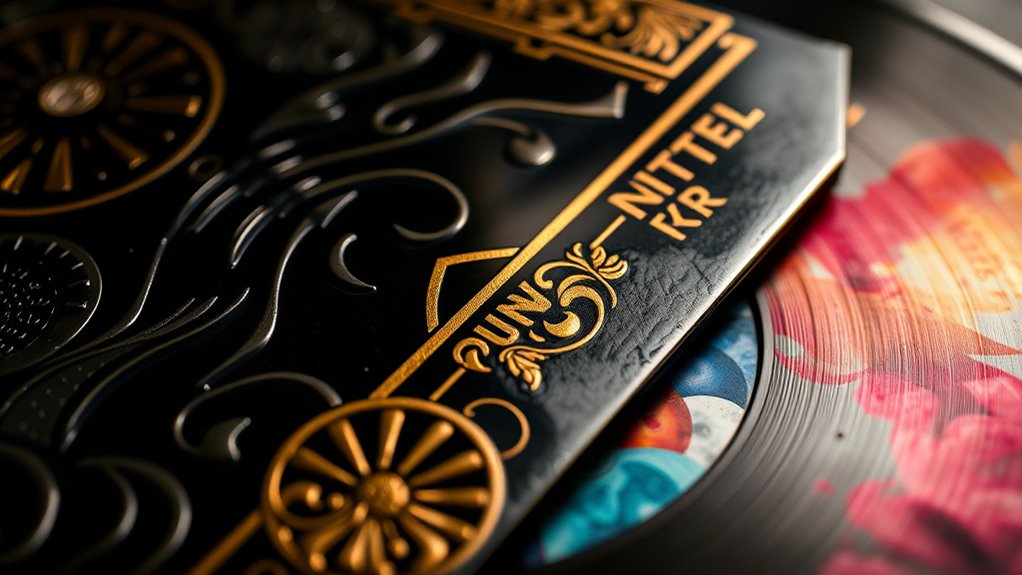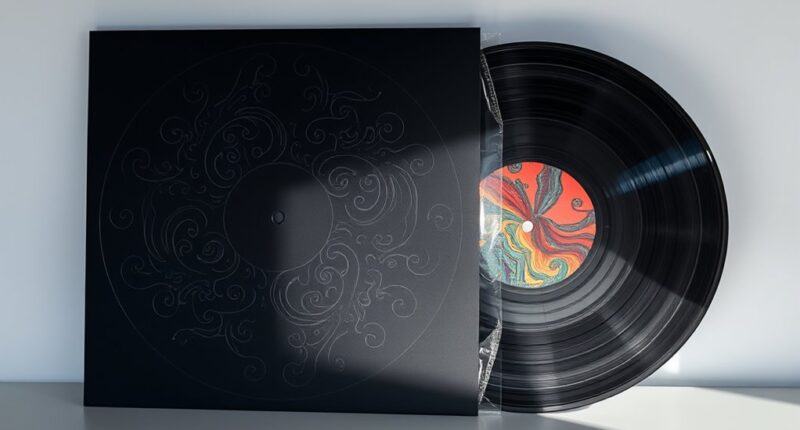When designing limited‑run vinyl packaging, focus on bold color schemes and textured materials to make your product stand out. Choose vibrant or subdued palettes that match your music’s mood, and incorporate textures like embossing or matte finishes to add tactile interest. Play with contrast, blending glossy accents with matte backgrounds to create visual impact. Every detail should reflect your album’s personality, offering a memorable experience. Keep exploring to uncover more ideas for crafting truly unique packaging.
Key Takeaways
- Choose bold, contrasting colors and tactile textures that reflect the album’s mood and genre for visual impact and emotional resonance.
- Incorporate textured elements like embossing or raised patterns to add depth and encourage tactile engagement.
- Use contrasting finishes, such as matte backgrounds with glossy accents, to highlight artwork and design features.
- Align color schemes and textures with the album’s theme, whether vibrant for energetic music or muted for ambient styles.
- Focus on creating unique, memorable packaging that balances visual appeal and tactile experience to elevate the collector’s value.

When designing limited-run vinyl packaging, you have a unique opportunity to create something truly special that captures the essence of the music and appeals to collectors. The first step is to carefully consider your color schemes. These choices aren’t just about aesthetics—they convey mood, genre, and emotional tone. Bold, vibrant colors can evoke energy and excitement, perfect for pop or punk records, while subdued, monochromatic palettes work well for jazz or ambient albums. Think about how colors interact; contrasting shades can create visual impact, while harmonious tones foster a sense of cohesion. Remember, limited runs mean every detail counts, so your color choices should stand out and complement the music’s personality.
Material textures are equally essential. Vinyl packaging isn’t just about the visual; it’s about how the packaging feels in your hands. You want to select textures that enhance the tactile experience and reinforce the album’s theme. Matte finishes lend a smooth, understated elegance, making the package feel premium and refined. Glossy surfaces, on the other hand, draw attention to artwork and details, offering a sleek, polished look. Incorporating textured elements—like embossed lettering or raised patterns—can add depth and dimension, making the packaging more engaging. These tactile features encourage collectors to handle the product with care, appreciating the craftsmanship involved.
Selecting textures like matte, glossy, or embossed elements enhances tactile appeal and reflects the album’s theme.
Furthermore, understanding the importance of Personality Test traits can help in tailoring designs that resonate emotionally with your target audience, creating a more personal connection with the collectors and fans. When combining color schemes with material textures, think about contrast and harmony. For example, pairing a matte background with glossy accents can create a striking visual effect that catches the eye. Similarly, using textured elements alongside vibrant colors can make certain features pop, drawing attention to key design aspects. It’s also important to consider how these choices align with the overall theme of the album. A vintage-inspired record might benefit from warm, muted tones paired with textured paper or fabric elements, while a modern, experimental release could embrace bold colors with sleek, minimal textures.
In the end, your goal is to craft a package that’s not just visually appealing but also a tactile experience that resonates with collectors. By thoughtfully selecting color schemes and material textures, you’ll create limited-run vinyl packaging that’s memorable, collectible, and a true reflection of the music’s identity. The effort you put into these details will elevate the entire listening experience, making your release stand out in a crowded market.
Frequently Asked Questions
What Are the Cost Differences Between Limited-Run and Mass-Produced Vinyl Packaging?
You’ll find that limited-run vinyl packaging costs more than mass-produced options due to the cost analysis involved. Smaller manufacturing scale means you miss out on economies of scale, so per-unit costs stay high. Custom designs, specialty materials, and unique finishes also drive up expenses. While mass production reduces costs markedly, limited runs require higher investment upfront, making them pricier but more exclusive for collectors or special releases.
How Does Limited-Run Packaging Impact Overall Production Timelines?
Think of limited-run packaging as a finely tailored suit—every piece is custom fabricated, which means it takes more time. You’ll likely face production delays because each batch requires extra attention to detail, unlike mass-produced options. This process can add weeks to your timeline, especially if you need special materials or intricate designs. Planning ahead and communicating clearly helps you stay on track despite these custom fabrication demands.
What Eco-Friendly Materials Are Suitable for Limited-Edition Vinyl Packaging?
You can use eco-friendly materials like biodegradable plastics and recycled cardboard for limited-edition vinyl packaging. Biodegradable plastics break down naturally, reducing environmental impact, while recycled cardboard offers sustainability and a vintage feel. These materials are durable and customizable, aligning with your eco-conscious goals. By choosing them, you make your packaging more sustainable, appealing to eco-minded consumers, and demonstrate your commitment to environmental responsibility without sacrificing quality or style.
How Can Branding Be Effectively Integrated Into Limited-Run Packaging Designs?
You can weave branding into your limited-run packaging like a master storyteller, making your visual identity shine. Use consistent colors, fonts, and logos to craft a cohesive look that tells your brand’s story at a glance. Incorporate unique design elements that evoke emotion and connect with fans. This seamless integration makes your packaging not just a container, but a visual narrative that leaves a lasting impression.
What Are the Best Practices for Preserving the Quality of Limited-Edition Vinyl Packaging?
To preserve the quality of your limited-edition vinyl packaging, you should apply protective coatings that prevent scratches and UV damage. Store your vinyl in a cool, dry environment away from direct sunlight and temperature fluctuations. Handle the packaging with clean hands or gloves to avoid fingerprints. Regularly inspect and maintain storage conditions, ensuring they stay stable. Proper preservation techniques keep your collectible packaging pristine and enhance its longevity.
Conclusion
So, as you craft your limited-run vinyl packaging, remember to blend timeless design with modern flair—think of it as channeling Da Vinci in a digital age. By paying attention to detail and creating an unboxing experience that feels like discovering a hidden treasure, you’ll captivate collectors and fans alike. Ultimately, your packaging becomes a tangible piece of art, turning every spin into a journey through history and innovation—an elegant nod to both past and future.







